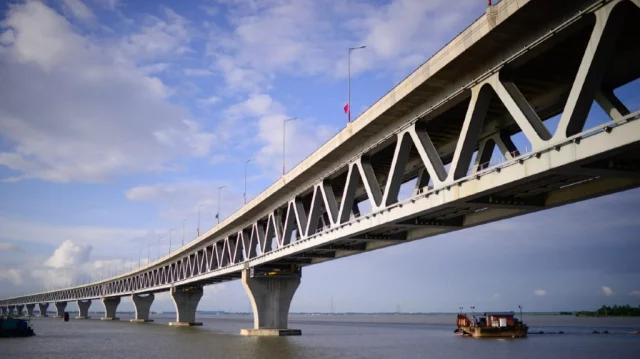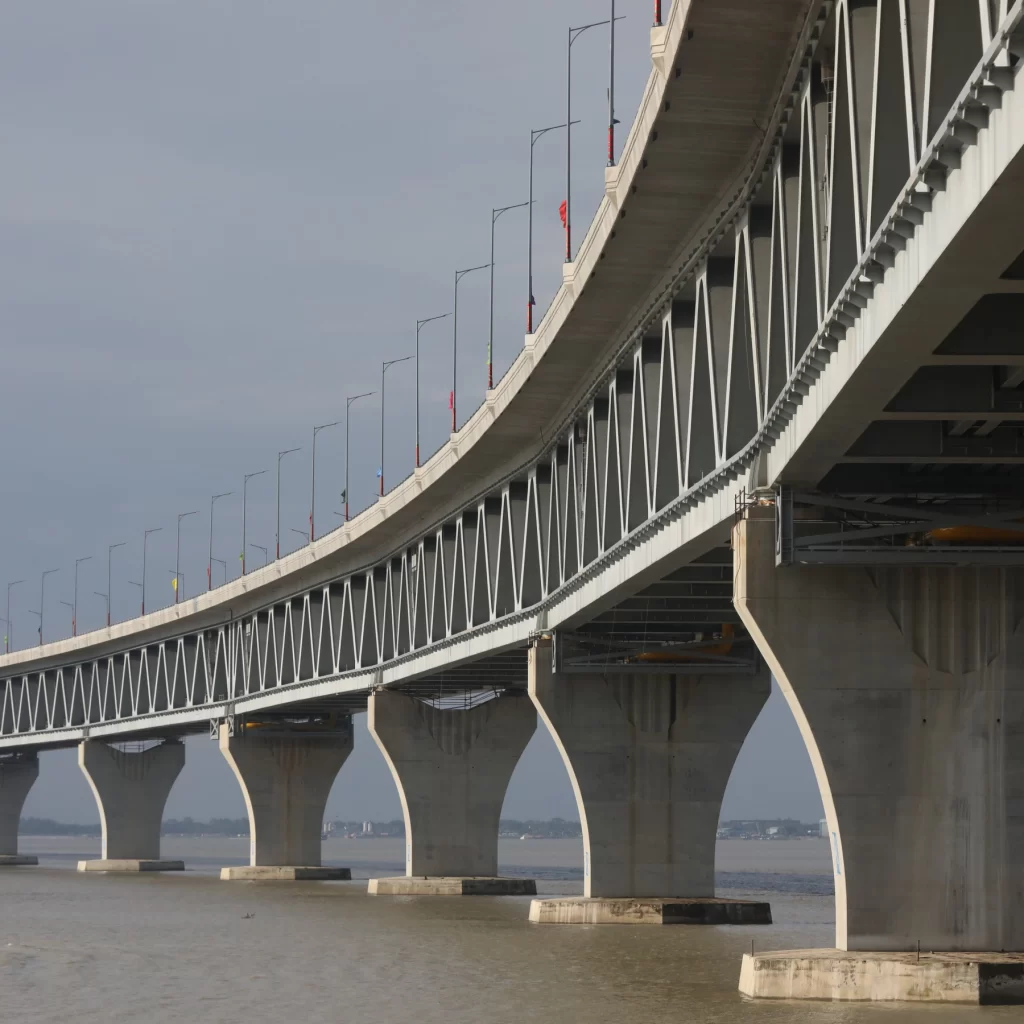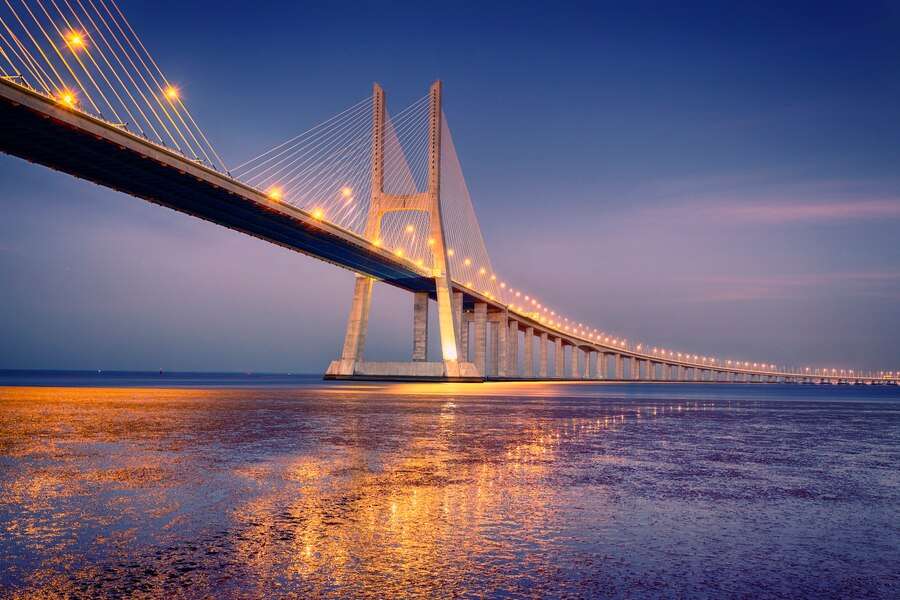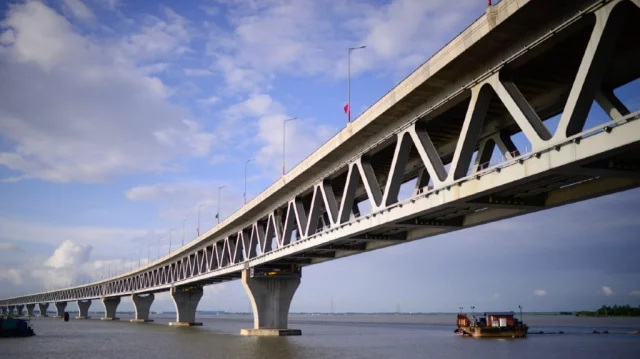
Overview of the Padma Bridge
The Padma Bridge, spanning the mighty Padma River in Bangladesh, stands as a monumental achievement in the nation’s infrastructure development. This multi-purpose road-rail bridge connects the southwestern region with the capital, Dhaka, significantly enhancing connectivity and fostering economic growth. As of its completion, the Padma Bridge ranks among the longest bridges in the world, showcasing Bangladesh’s engineering capabilities on the global stage.
The project aimed to bridge the geographical divide between the southwestern region and the rest of the country, which had long been a bottleneck for development. By linking these regions, the Padma Bridge is expected to transform the socio-economic landscape, making it one of the most significant infrastructural projects in the history of Bangladesh.
Construction and Development
Initiated in 2014, the construction of the Padma Bridge was an ambitious project involving state-of-the-art engineering and substantial financial investment. The bridge, designed to withstand the challenging river dynamics and heavy monsoon flows, is 6.15 kilometers long and 18.10 meters wide. Its construction involved complex geotechnical and structural engineering feats, making it one of the most challenging projects ever undertaken in Bangladesh.
The primary designer of the Padma Bridge was AECOM, a renowned American multinational engineering firm known for its innovative and sustainable infrastructure solutions. The construction process required significant technological innovations and rigorous planning. The river’s unpredictable nature posed a considerable challenge, necessitating the use of advanced geotechnical surveys and riverbed analyses to ensure the bridge’s stability and durability.
Key components of the construction included the installation of deep-water foundations, the use of high-strength steel and concrete, and the implementation of seismic resistance features to withstand potential earthquakes. The bridge’s construction involved over 40,000 workers and engineers, reflecting a massive collaborative effort that spanned several years.
Opening Ceremony
The Padma Bridge was officially inaugurated on June 25, 2022, by the Prime Minister of Bangladesh, Sheikh Hasina. The grand opening ceremony was a momentous occasion, attended by dignitaries, international guests, and thousands of proud citizens. This event marked a new era of connectivity and economic potential for the region, fulfilling a national dream of bridging the Padma River.
The inauguration was celebrated with much fanfare, including cultural performances, speeches, and a spectacular display of fireworks. The event was broadcast live, symbolizing national pride and unity. The Prime Minister’s speech highlighted the bridge’s significance, not just as a physical structure but as a symbol of Bangladesh’s resilience and capability.

Controversy and Rumours
Throughout its development, the Padma Bridge project faced numerous controversies and rumors. Allegations of corruption and financial mismanagement led to international donors withdrawing their support. The World Bank, initially a major financier, pulled out in 2012, citing concerns over corruption. This withdrawal posed a significant financial challenge and cast doubts on the project’s viability.
However, the government of Bangladesh decided to self-finance the project, showcasing resilience and commitment. This bold move was unprecedented, reflecting the nation’s determination to complete the bridge despite the obstacles. Despite challenges, the successful completion of the bridge stands as a testament to national determination and engineering prowess.
Rumors about the bridge’s construction also included superstitions and local myths, such as the need for human sacrifices to ensure its stability. These rumors were widely circulated but were debunked by authorities and experts. The government’s transparency and public engagement efforts helped to address these concerns and maintain public trust in the project.
Usage and Benefits
The Padma Bridge has drastically reduced travel time between Dhaka and the southwestern districts, promoting trade, tourism, and regional development. It facilitates better access to healthcare, education, and markets, thereby improving the quality of life for millions. The bridge is also expected to boost the national GDP by an estimated 1.2%. The dream of the Padma Bridge was to create a seamless connection that would drive economic progress and improve the socio-economic conditions of the southwestern region of Bangladesh.
The bridge supports a four-lane highway on the upper level and a single-track railway on the lower level, catering to both vehicular and rail traffic. This dual-purpose design enhances its utility and maximizes its impact on regional connectivity. The improved transportation infrastructure has led to increased investment in the southwestern region, with new businesses and industries emerging along the corridor.
Moreover, the bridge has facilitated faster and more efficient transportation of goods, reducing costs and transit times. Agricultural producers in the southwest now have better access to markets in Dhaka and beyond, enhancing their profitability and contributing to regional economic growth. The bridge has also promoted tourism, with easier access to attractions in the southwest, boosting local hospitality and service industries.

Toll and Revenue
The Padma Bridge has established a robust toll collection system to ensure its maintenance and operational sustainability. Since its opening, the bridge has recorded impressive toll revenues, reflecting its heavy usage and significance as a key transport link. The toll rates are designed to be affordable while generating sufficient revenue to cover maintenance costs and contribute to the bridge’s long-term financial health.
Toll Earning Record
The Padma Bridge has set new records in toll earnings, highlighting its pivotal role in regional transportation. The bridge recorded over $1 million in tolls within the first month of its operation, demonstrating its immediate impact on connectivity and transportation efficiency. The toll revenue is expected to play a crucial role in the bridge’s long-term financial health and upkeep, ensuring that it remains a vital artery for years to come.
See Also
- Jamuna Bridge
- Bangabandhu Sheikh Mujibur Rahman Tunnel
- Meghna Bridge
References
- Government of Bangladesh publications
- News articles from local and international media
- Engineering case studies on the Padma Bridge
- Economic impact reports from financial institutions
Conclusion
The Padma Bridge is more than just a physical structure; it is a symbol of national pride, engineering excellence, and economic transformation. Overcoming numerous challenges and controversies, the bridge stands as a testament to Bangladesh’s resilience and determination. It promises to usher in a new era of connectivity, regional development, and socio-economic progress, fulfilling the dreams of millions and paving the way for a brighter future.
The successful completion and operationalization of the Padma Bridge underscore the potential for developing nations to undertake and complete large-scale infrastructure projects through self-reliance and innovative solutions. As the bridge continues to drive growth and development, it serves as an inspiration and a model for similar projects worldwide.

4o
